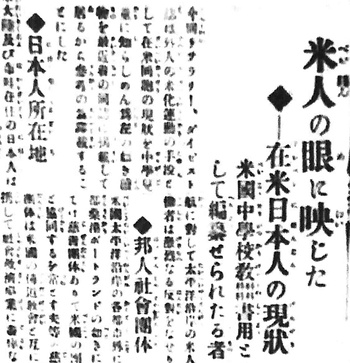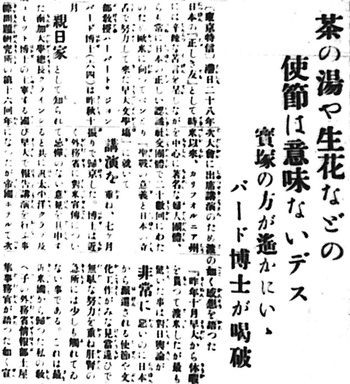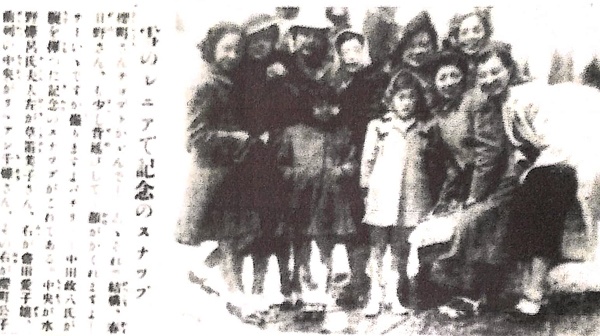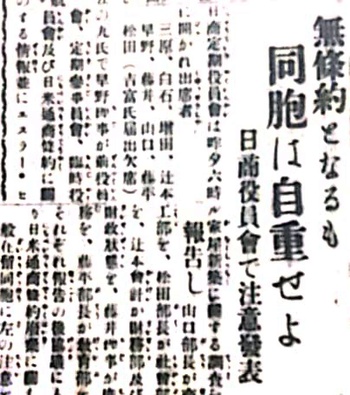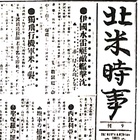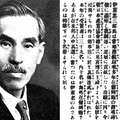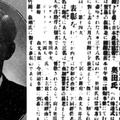US view on Japan
“Current situation of Japanese Americans Viewed from the American point of view—Nationalism Among Japanese: Edited for use in the US Middle school textbook” (November 13, 1919 issue1)
Nationalism is said to be of utmost importance in the life of Japanese. In reality, however, the Japanese are people who are loyal to the country they immigrated to rather than their country of birth.
In the past, when Japan was divided into many domains, it was a common custom that when one left their original domain and moved to another, they dedicated their life to the new adopted domain. The Japanese have preserved such a good practice to the present day. It is common for Japanese politicians visiting the US to advise Japanese Americans to be loyal to the US.
“American Sentiment towards Japan” (March 7, 1938 issue)
Mr. Shunsuke Tsurumi returned to Japan on the Hikawamaru on the 5th and stated the following at his departure:
“I stayed in New York and Washington. I contacted my friends during this visit. The feeling towards Japanese is still negative but there is a tendency of gradual softening. This is my seventh visit to the US, but this is the first time I did not give a speech. Even if I were to explain the Japanese position to the Americans now, they would intentionally ignore it. So I decided not to try and forcefully persuade but rather to listen to them. Most Americans do not think badly of the Japanese personally, but naturally dislike the war, which leads to ill feeling towards the Japanese.”
Mr. Sumiyoshi Arima, the president of the North American Times, spoke about American sentiment towards Japan in his column “Hokubei Shunjyu,” written under the alias Ichiro Hanazono, as follows:
“American Sentiment towards Japan” (January 4, 1939 issue)
The American sentiment towards Japan seemed to ease a bit for a while, but recently it worsened a lot, and the tendency to the UK and US to coordinate is becoming clear…. If you ask whether the US intends to oppress Japan through the act of war, it is hard to think they are resolved to that extent….
The US wants to pressure Japan in some way or take a retaliatory measure, but does not want to jump into the whirlpool of conflict. They have a dilemma, not wanting to give up their unique traditional isolationism. The UK is beginning to extend a helping hand, and while Americans are afraid, they are already going along with that. The joint stance of the UK and US against the Far East is already indisputable.
“Tea Ceremony and Ikebana Delegations are Meaningless. Professor Bard of the Literature Department of Waseda University” (June 6, 1939 issue)
Professor Herbert John Bard (64) of the Literature Department at the Waseda University has been in Japan for 28 years. He has made efforts to spread a correct understanding of Japan in the West through his writing and speeches.
During his visit to California last October to give a lecture at the 16th annual conference of the Research Group on International Issues, hosted by the USC President Professor Kleinschmidt, who is known for his friendliness towards Japan. While in California, he went on a tour and gave the talk “Holy War and the Position of Japan” for 20 times at notable women’s organization and social organizations mostly in California. He returned to Japan after 7 months....
Dr. Bard spoke about his impression at the Imperial Hotel as follows:
“I traveled to the US last October during a break from Waseda University. It was most surprising to find that the general opinion towards Japan is quite negative, while the missions sent from Japan and cultural strategies are missing the point, merely repeating useless efforts and failing to address the most crucial issues….
In order to get a country like the US, with its practical and prompt attitude, to understand the real intention of Japan, the best approach is direct questions and answers. The delegates sent should not only be humane but also active. Cultural diplomacy is fine, but for the Americans in this fast-paced age, tea ceremonies, ikebana, noh, and kabuki lectures, and such delegations are useless. It is nonsense to use such tools to improve the public opinion of Japan.
To impress the Americans, high Japanese literature, poetry, and art represented by Lafcadio Hearn (Koizumi Yakumo), or delegations of pure Olympic athletes, Judo and Kendo students, and upbeat Takarazuka girls’ troupes would be far more effective.
Americans are quite impressed by Japanese sports prowess. Making them feel that Japan is extremely respectable and great is the only way to improve the public perception of Japan. As a friend of Japan, I would like to sincerely advise the Japanese government.”
The Takarazuka Girls’ Troupe Contributes to US-Japan Friendship
Takarazuka Girls’ Troupe left Japan on April 5, 1939. After successful performances in San Francisco and New York Expositions in front of large white audiences, they continued on to Portland on June 8, and then to Seattle on the 13th. They toured the city on the 14th and attended the welcome party of the Sun Girls. The main street was mobbed by the crowd, as if it was a festival.
“Takarazuka Girls’ Troupe to Perform for the First Time Tonight” (June 17, 1939 issue)
The last performance in the US will begin in Seattle at 8:30 p.m. tonight. Ticket sales are going well, and a full house is expected. The program starts with Takarazuka Ondo, sang by Yumika Sakurazono, Chisuzu Hibiki, and 30 Takarazuka girls. Fukuko Sayo and Kimiko Sakuramachi will perform Goshugi Sanban Uta, followed by 18 stage performances, including Kasugano Yachiyo, Kusabue’s Girls of Osaka. In addition, one-scene plays, including Hikone Byobu, are scheduled. The performance will be repeated tomorrow, Sunday at 3 p.m. and 8:30 p.m.
“Rainer of Snow Commemorative Snapshot” (June 17, 1939 issue)
Mrs. Mizuno in center, Mitsuko Kusabue on the left, Akiko Kasuga Aiko on the right, front row center Ann Lee, Kimiko Sakuramachi, to her right, taken by Nanako Seihachi on June 15.
The US visit by Takarazuka Girls’ Troupe contributed greatly to building US-Japan relations and boosted the friendly relationship with Japanese communities in Seattle.
Japanese Americans in Seattle who Worked to Improve US-Japan Relations
Sumiyoshi Arima, president of the North American Times, stated on the US-Japan relations in his column “Hokubei Shunjyu” as follows.
“The Responsibilities of Both Japan and the US” by Ichiro Hanazono (October 27, 1939 issue)
“The intention and efforts to get the US-Japan relations back on track are increasing between the two governments, and that is a welcome positive development for the current situation in the pacific….
It is self- indulgent to wonder what Japan will do in absence of US supervision. That only reveals a lack of knowledge about the East among American citizens. The notice of the abolition of the trade treaty is one such example, showing that US-Japan friendship begins with Japan lowering its head to explain and beg.
No one in Japan believes that US-Japan relations will work by Japan lowering its head now. US-Japan relations are our absolute demand. They secure the Pacific. US-Japan relations should be based on equal status. That is the responsibility of both parties. International adjustments that are not based on such recognition do not exist.
Nissho’s regular board meeting appealed to the Japanese in Seattle as follows:
“Even in the Absence of the Treaty, Japanese Should Act with Self-Restraint” ( December 12, 1939 issue)
As a result of the notice from the US government, the current trade treaty will expire on January 26 next year, and it is unclear if there will be a new treaty to replace it. Do not act without careful thought, loyally hold each own position, and be mindful not to waste the 50-year history built through the difficulties experienced by our predecessors.
After the regular board meeting, consular Sato, Mr. Chuzaburo Ito, Mr. Eihan Okiyama, Mr. Kunizou Maeno , Mr. Sumiyoshi Arima, and Mr. Murao Yusen participated and discussed this crucial topic.
There are many articles hoping for the new treaty after the expiration of the US-Japan Treaty of Commerce and Navigation. Despite these hopes, however, we are forced to live in America under no treaty after January 26, 1940.
It is my opinion, Japanese in Seattle have always worked to improve US-Japan relations. As mentioned in Chapters 21 and 22, in 1938 and 1939, Japanese communities in Seattle eagerly contributed to the community chest and participated in potluck festivities to maintain friendly relations with the white society. I observed that despite the deterioration of US-Japan relations, the Japanese communities in Seattle worked to co-exist, mutually prosper, and build friendly ties with the white community. I also noticed that Nihonjinkai, Kenjinkai, the Barbars’ Association, Hotel Business Union, and other Japanese groups in Seattle all constantly made efforts towards fostering a friendly US-Japan relationship.
From the Author
The 24-chapter series, through the articles in the North American Times showed how Japanese communities in Seattle—both the first generation who built the foundation and the second generation who expanded on it—worked and exerted efforts in various fields despite numerous difficulties. I am grateful that this series was read by many.
*The excerpts from the articles include summary of the original.
Note:
1. All article excerpts are from The North American Times unless noted otherwise.
References
The Committee of Japanese in America for Preserving Historical Events, ed., Zaibei Nihonjin Shi (History of Japanese in America), Zaibei Nihonjin-kai, 1940.
Kazuo Ito, America shunju hachijyu nen (America Spring and Autumn 80-Year), PMC Publishing, 1982.
Masako Iino, Mouhitotsu no Nichibei Kankeishi (Another History of the US-Japan Relationship), Yuhikaku Publishing, 2000.
*The English version of this series is a collaboration between Discover Nikkei and The North American Post, Seattle’s bilingual community newspaper. This article was originally publishd in Japanese on March 27, 2023 in The North American Post.
© 2023 Ikuo Shinmasu


